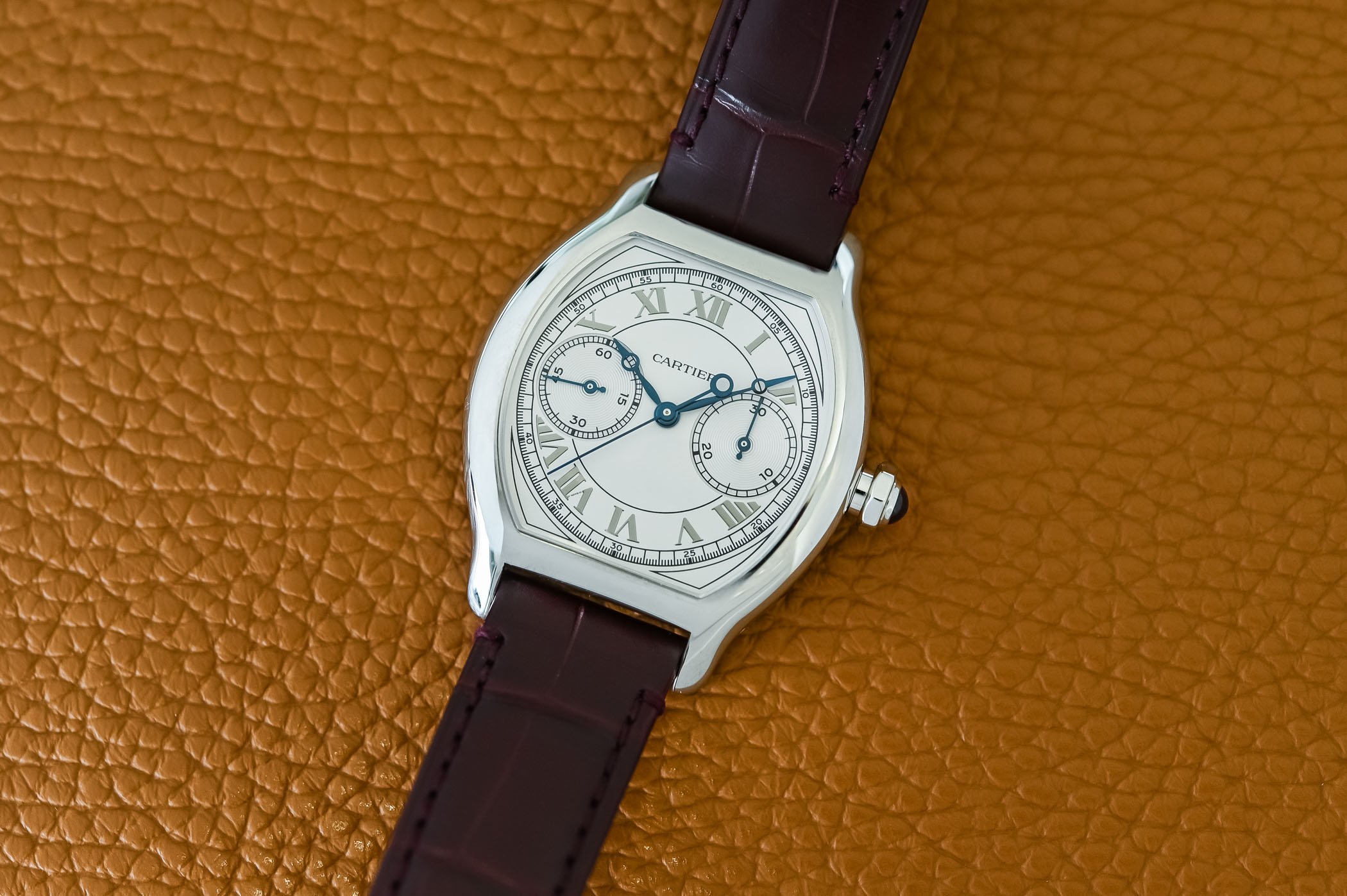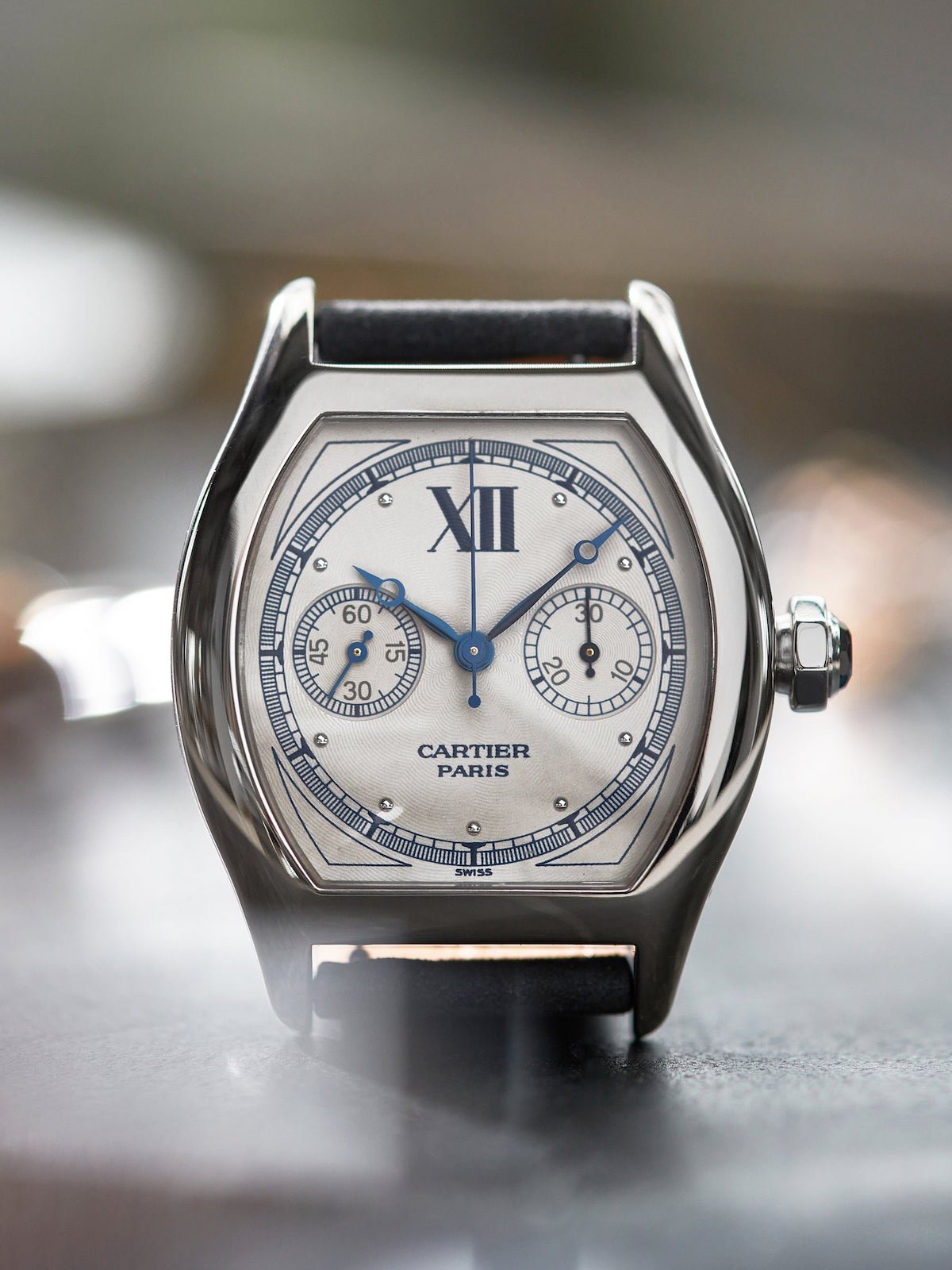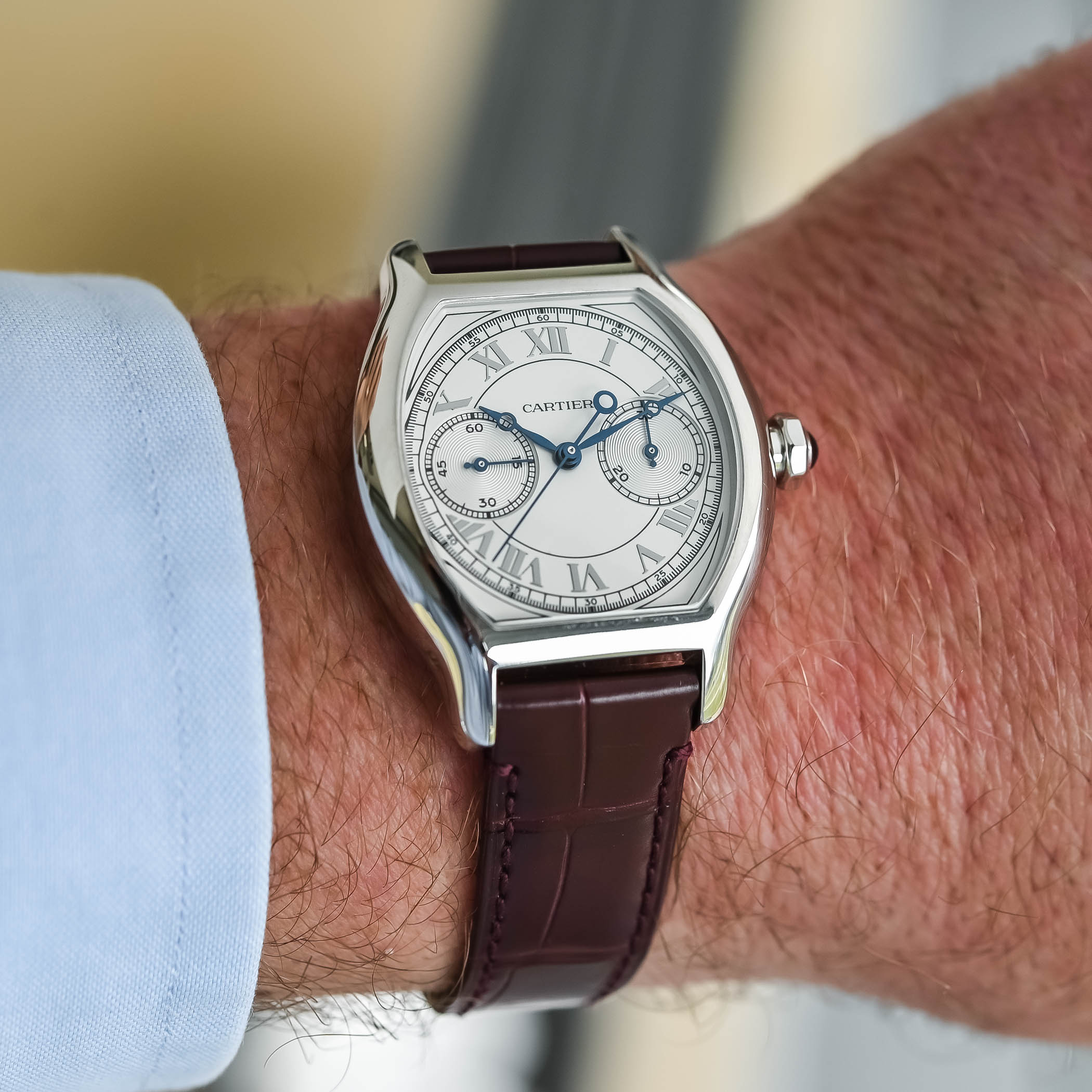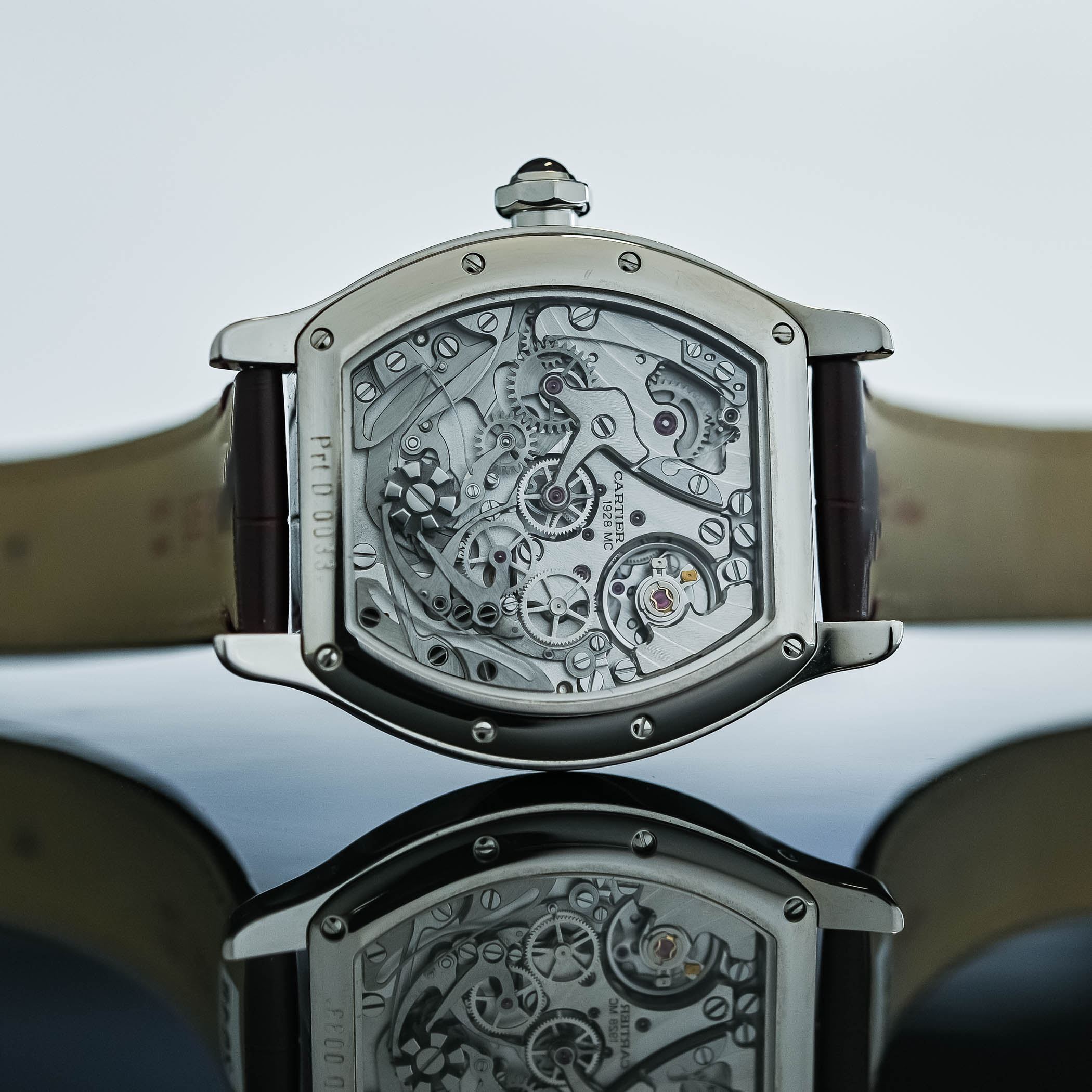The Return of the Cartier Tortue Monopoussoir Chronograph
One of Cartier's most desirable watches, better known for its 2000s CPCP version, is back with new mechanics and a refreshed design.

Cartier has staged a strong comeback amongst collectors in recent years thanks to its ever-growing Cartier Privé collection and other historic recreations such as the Pebble, Crash and Tank Cintrée. A range of high-end, mechanically advanced and visually appealing watches, it can be seen as the resurgence of the all-time favourite Collection Privée Cartier Paris, also known as the CPCP collection. And since this topic is now on the table, we can’t skip the most popular model in this range, the refined Tortue Monopoussoir Chronograph and its movement. So, without further ado, I’ll drop the big news… It is back! Meet the new 2024 Cartier Tortue Monopoussoir Chronograph. And yes, it is as good as it gets.
Historical Reminder
Cartier is all about shapes. We’ve covered this topic in a dedicated article, looking at some of the most emblematic designs ever created by the Parisian brand. While the Tank collection is the most famous of them all – whether it is Cintrée, Normale, Chinoise, Française, Américaine, Asymétrique, à Vis, Basculante, or à Guichet – more names have shaped the brand’s history like Cloche, Tonneau, Santos and, for today’s matters, the Tortue (turtle in English).

The Cartier Tortue followed two other important models – the Santos in 1904 and the Tonneau in 1906 (at least according to Cartier’s archives) – to become the third member of the growing collection of the Parisian jeweller-watchmaker in 1912. First presented in a time-only version, it defined itself with its smooth barrel-shaped case, which could be described as a turtle on legs…

Once this design was established, Louis Cartier decided to introduce different movements and complications inside this elegant model, starting with a minute repeater. And then came what’s probably the best-known version, a chronograph in 1926 or 1928 – dates are still being debated, as Cartier claims 1928, while we have found in Le Temps de Cartier book by Barracca, Negretti and Nencini a version from 1926. As was the case for most chronographs back in the day, this Tortue was a monopusher (monopoussoir) with functions actuated by a single crown-pusher. The small watches, with cases of about 26 x 35mm, were powered by movements sourced from EWC (European Watch & Clock Co. Inc.), a joint venture between Cartier and Edmond Jaeger.
The first re-edition of the Tortue Monopoussoir within CPCP
In 1998, Cartier presented a collection of watches that made a lot of noise back then and is still regarded as one of the most collectable series of watches from the Parisian brand, the Collection Privée Cartier Paris (also known as the CPCP collection produced from 1998 to 2008). Based on the recreation of historical models, this collection had it all: visual elegance, mechanical finesse, sense of detail, and exclusivity, it revisited the brand’s archives and brought back dormant designs. Besides the visual appeal, most of these watches used fine hand-wound movements done in collaboration with great names – Piaget or Jaeger-LeCoultre- and movement specialists such as Renaud and Papi and THA.

Among a few dozen watches, which include oddities such as the Tank Monopoussoir, the Tank à Guichets or the Tank Asymétrique, one watch clearly stands apart for several reasons: the CPCP Tortue Monopoussoir Chronograph. A combination of elegance, restrained eccentricity and mechanical refinement, it has since become one of the brand’s most collectable modern models.

The 1998 re-edition of the Tortue Monopoussoir Chronograph came in the shape of an enlarged watch, slightly more muscular (at least in width and roundness) than its historical counterpart, with a thicker bezel. First presented in yellow gold, it measured 35mm in width and 43mm in length. While sharing similarities with the 1920s version, the dial had also been modernised. Both the old and the CPCP versions of the Tortue Monopoussoir feature Roman indexes and a railroad track. The 1990s/2000s standard (yellow gold) version, however, features a guilloché dial.

One of the most appealing elements of the CPCP version is to be seen on the back: a thin, compact, refined hand-wound monopusher chronograph movement with a column wheel and oscillating pinion mechanism. It was developed by a joint venture named THA (Techniques Horlogères Appliquées), created in 1996 by famous indie watchmakers Vianney Halter, Denis Flageollet, and Francois-Paul Journe. Dubbed calibre 045MC, this movement alone is enough to explain the popularity of the Cartier Tortue Monopoussoir Chronograph CPCP.
Following the inaugural yellow gold model, several other editions were presented with the CPCP collection, such as the more contemporary white gold version with large XII, an ultra-rare salmon dial model with a marker at noon replaced by a 13 numeral (limited to 13 pieces for the Paris boutique located 13 rue de la Paix) and later a larger version, still with the same movement, named Tortue Monopoussoir XL.
The 2024 Cartier Privé Tortue Monopoussoir
So… this is simple: the Cartier Tortue Monopoussoir is back. Yes, it looks fabulous. Yes, it is still a pretty small watch by today’s standards. Yes, it has retained most of the elegance of the CPCP collection. Yes, it is an exclusive edition that’ll be hard to obtain. Yes, it’s far from cheap… But no, it isn’t entirely the same as the CPCP model. And no, there’s no THA movement inside, even though the rights for its design have been acquired by La Joux-Perret and the movement, slightly modified and upgraded, is now reproduced. There’s a new, purpose-built movement inside, and it’s far from low-end.
Let’s start with the basics. What does this new 2024 Cartier Privé Tortue Monopoussoir Chronograph look like? Presented in yellow gold or platinum, as photographed here, my first joy was seeing a compact case that boasts almost the same proportions as the inaugural CPCP version. At 34.8mm in width, 43.7mm in length and only 10.2mm in thickness, this new Tortue Monopoussoir is a small watch. And I love that Cartier didn’t go for an XL version. On the wrist, it exudes incredible elegance and charm, with an outdated feeling that perfectly fits the whole spirit of this watch.
Entirely polished, the case features sapphire crystals on both sides and a crown set with a ruby or a sapphire cabochon (depending on the case material). Eight screws secure the back, and the water-resistance is limited to 30 metres… But it is the least of my concerns in this context. The overall shape, even if not entirely identical to the CPCP version, certainly feels very close.
The dials are, however, slightly different and, in this respect, do come closer to the vintage 1920s/1930s models than the CPCP editions. This is mostly due to the use of a flat base rather than a guilloché pattern. The platinum edition comes with a silvered opaline dial and thin metallic appliques for the Roman numerals. The yellow gold model has a grained gold-finish dial with black printed Roman numerals. On both, the sub-counters are snailed and time is indicated by apple-shaped hands in blued steel.
An element that was unique to the old CPCP white gold version also finds its way back in this modern resurrection: the outlined triangles in each corner of the dial. The scales of the sub-counters have also been slightly simplified and streamlined, resulting in a pleasing visual balance and legibility. One could potentially argue that Cartier is cutting costs by creating these smooth dials instead of a guilloché pattern but I personally think the watch looks fabulous as it is… To each his own, of course.
Turn the Cartier Privé Tortue Monopoussoir over, and you’ll discover something intriguing: the new calibre 1928 MC. As mentioned, we’re not talking about an ETA or ValFleurier base movement with a monopusher chronograph module on top, but about a custom-made shaped calibre with traditional, high-end architecture. About the provenance, this isn’t an in-house but a proprietary movement made by an undisclosed partner.
This calibre 1928 MC combines traditional elements, such as the use of a mainplate following the lines of the case, hand-wound architecture, a column-wheel and horizontal clutch duo and a thin construction – at 4.3mm in thickness, it is the brand’s thinnest chrono – with more modern features such as a balance beating at 28,800 vibrations/hour. The power reserve is decent at 44 hours. The decoration is fairly advanced, with curved Geneva stripes, bevelled angles on the bridges and levers/springs and brushed surfaces on the steel parts. The look and feel of the movement is, on the other hand, quite modern with its monochromatic approach – something that contrasts with the overall historical style of the watch.
Availability & Price
The 2024 Cartier Privé Tortue Monopoussoir Chronograph will be produced in 200 platinum and 200 yellow gold pieces. Each is delivered with two interchangeable straps. Prices will be EUR 46,000 or CHF 49,100 in gold and EUR 53,000 or CHF 57,000 in platinum. It is far from accessible, but in the meantime, the CPCP models have also gone up drastically.
For more details, please visit cartier.com.
















1 response
wow, speechless, this is incredible!
the movement, while devoid of legend, looks amazing.
I am still kicking myself for failing to buy the CPCP version at 13-15K a few years ago… Live and learn!